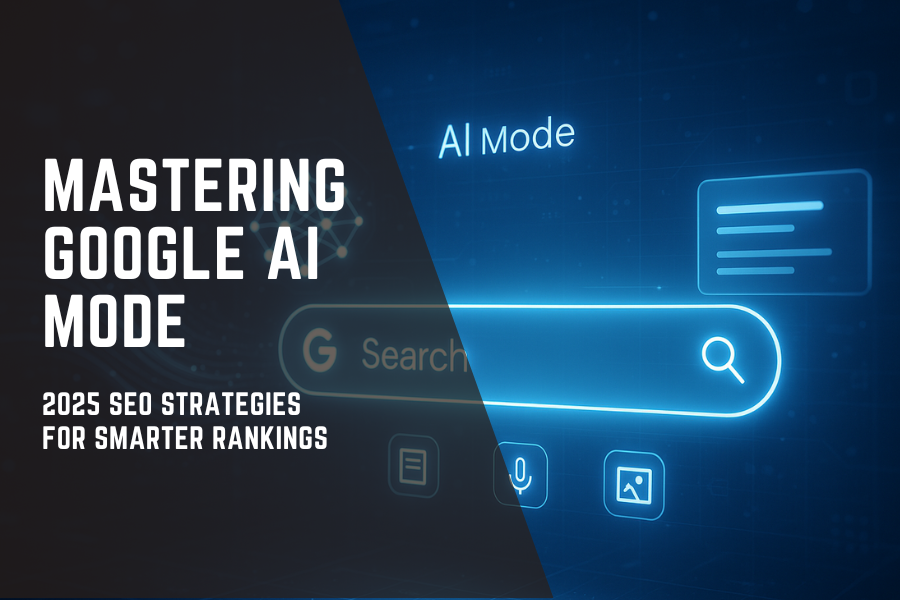Stuck with slow search? Well, not anymore. Google introduced its new feature, AI mode. AI mode is not just any feature but a complete package of a search engine with detailed searches.
Being AI-powered, the search generative experience just got easier.
AI-enhanced search is not just a temporary beta but the future of how users will interact with information. One of the most dramatic transformations in the history of search is this shift, comparable to mobile-first index or the arrival of featured snippets. For SEOs, content creators, and digital marketers, the message is clear: adapt or fall behind.
Time to understand :
● What Google’s AI Mode (SGE) is
● How it impacts traditional search rankings
● What SEOs need to start doing now to win
● Tools, tactics, and examples to future-proof your SEO strategy
What Is Google’s AI Mode (SGE)?
Google’s Search Generative Experience (SGE) introduces an AI-enhanced search interface that:
● Summarises results with AI-generated answers at the top of SERPs.
● Answers complex queries in conversational formats.
● Pulls in multiple sources, images, and links within the AI summary itself.
Instead of showing just the “10 blue links,” users may now see a dynamic AI snapshot with relevant info, comparisons, pros and cons, and related links all before they scroll to organic listings.
This AI summary is powered by large language models (LLMs), similar to ChatGPT, but integrated into the search environment.
With SGE, one can now easily discover topics and insights, not only that, but also give Conversational Search and Follow-up Questions, AI-generated content, Enhanced Product Discovery, Improved User Experience, and Potential Impact on SEO.
Why This Changes Everything?
Traditional SEO focused on optimising content for:
● Keywords
● Link building
● Snippets and schema
● Core Web Vitals
While these are still essential, AI Mode introduces new variables, such as:
● How your content is interpreted and summarised by AI
● Whether your content is selected to appear in AI snapshots
● A possible decline in clicks for organic results below the AI summary
How AI Mode Affects Search Behaviour
AI mode is shifting user search behaviour :
1. More Zero-Click Searches
With comprehensive answers presented up front, users often don’t need to click through to a website.
It’s Implication: You need to optimise for visibility within the AI summary, not just ranking.
Users can now read about any topic without actually searching. The AI provides users with information and detailed search without them actually going to any web links.
2. Complex Queries Are Growing
Searchers are asking multi-part questions
e.g., “What’s the best AI tool for graphic design that integrates with Canva and has a free plan?”
The traditional SEO wasn’t built to answer that elegantly. But, AI Mode is. Content needs to answer questions holistically, combining features, comparisons, use cases, and examples.
3. Conversational Search Patterns
Search is becoming more natural-language driven , like chatting with a virtual assistant. This has led to communication taking a back seat in reality in most cases.
Keyword stuffing and robotic phrasing are obsolete. AI is being made to write like a human for human.
What SEOs Need to Do Now
Let’s get tactical. Here’s how to thrive in Google’s AI Mode:
1. Focus on First-Hand Expertise (EEAT)
Google’s AI relies heavily on its EEAT signals: Experience, Expertise, Authoritativeness, and Trustworthiness to decide which sources to pull from.
Experience includes content done by people and not just research.
Example:
A blog by a professional photographer about the “Best Lenses for Portraits” will carry more weight than a generic AI-generated article.
Here is how experience is depicted:
● Using first-person language: “I used X lens on a Canon R5 and here’s what I found…”
● Including images, videos, or screenshots from your own experience
● Sharing real case studies, use cases, or behind-the-scenes insights
Expertise includes: Topic mastery. One needs to show that they understand the subject deeply and accurately.
Example:
A CPA writing about tax-saving strategies shows more expertise than a general lifestyle blogger covering the same topic.
Expertise depiction includes:
● Adding author bios with qualifications, awards, credentials
● Referencing real data, reputable studies, and updated statistics
● Answering not just the what, but the why and how
Authorativeness includes:
Content from trusted authorities in a space and not just knowledgeable people, but recognised ones.
Example:
A link from HubSpot or Moz about SEO will likely be referenced more in SGE than a brand-new blog.
Here’s how authoritativeness can be shown:
● Getting mentions, backlinks, or quotes on authority sites (Forbes, TechCrunch, etc.)
● Building a strong brand presence across the web (LinkedIn, podcasts, guest posts)
● Using structured data to link social proof
Trustworthiness can be explained as:
AI summaries pull from sources that users can rely on those which are transparent, ethical, and credible.
Example:
A product review site that discloses affiliate partnerships and shows real user feedback will be trusted more than a shady, ad-riddled site.
How can trustworthiness be shown?
● Using HTTPS and secure user data
● Clearly displaying contact info, policies, and editorial standards
● Fact-checking your content and updating regularly
Action steps can include:
● Adding author bios and credentials to content
● Including case studies, original research, screenshots
● Sharing firsthand insights and experience-based answers
● Using “I,” “we,” or client-centric language to show authenticity
2. Target AI-Friendly Content Formats
Content that works well with LLMs is:
● Clear and logically structured
● Uses headings and bullet points
● Answers questions succinctly and in-depth
Steps for searching:
● Using question-based headers: “What is…” “How does…”
● Creating comprehensive guides (long-form still wins in AI summaries)
● Building content that answers multiple aspects of a query
3. Use Schema Markup Strategically
Structured data still matters even more now as it helps Google (and its AI) understand your content more clearly.
Few things that will help with better search results:
● Implementing FAQ, HowTo, Product, and Review schemas
● Using author, datePublished, and headline for blog articles
● Adding sameAs properties to link social proof and brand authority
4. Create Comparison & Decision-Based Content
SGE often handles “Which is better…” or “What’s the difference…” type searches.
● Writing detailed comparison posts (Tool A vs Tool B)
● Using comparison tables and pros/cons
● Answering “Who is it for?” and “When should you use it?” in content
This not only gives a better idea but also provides better results.
5. Leverage UGC and Social Signals
AI models often factor in popularity, brand mentions, and sentiment from across the web.
● Encourage user-generated reviews, testimonials, Reddit/Quora mentions
● Build digital PR campaigns for brand mentions on authority sites
● Share real user feedback in your content to reinforce trust
6. Optimise for Follow-Up Questions
In AI Mode, users are shown follow-up questions (suggested prompts). If you can rank for those, you extend your visibility.
● Predict and include related questions in your content
● Use sections like “You might also be wondering…” or “Related FAQs”
● Use internal linking to keep users on-site longer
7. Refresh Content More Frequently
AI may prefer fresher, more up-to-date content, especially for topics like finance, health, or tech.
● Set a quarterly content update schedule
● Add a “last updated” field
● Use changelogs in tools or product-related content
Tools to Help You Optimise for AI Mode
Here are some tools to use for optimised search:
● Alsoasked: understands follow-up Qs. it is great for predicting AI suggestions.
● Surfer SEO: follows content structure, helps with NLP terms and outlines.
● Schema.org Generator: uses structured data and is good for Quick setup for makeup.
● Google Search Console: tracks impressions and sees if AI traffic is dropping or shifting.
● Exploding Topics: track trends and catch content ideas early.
Will AI Replace Traditional SEO?
Not entirely. But it is replacing how search engines present information.
We’re entering an era where ranking is only part of the equation. To succeed in AI Mode, your content must:
● Be selected by AI
● Be summarizable by AI
● Be credible and human-first
The traditional SEO metrics like DA or backlinks won’t go away, but they’re now one layer of a multidimensional visibility system.
The Bottom Line: New Era, New Playbook
Google’s AI Mode is not an algorithm tweak, it’s a paradigm shift.
SEOs and marketers must reorient their strategies to align with AI behaviour, not just search engine crawlers.
Those who act now by optimising for AI summaries, building trustworthy and holistic content, and embracing natural language will lead the next wave of organic visibility.
SEOs Should:
● Build trust with EEAT-rich content
● Answer complex, layered queries
● Use schema and structured formats
● Include firsthand insights and real-life examples
● Target comparison and decision-making content
● Refresh often and monitor follow-up questions
● Think visibility in AI summaries, not just page rank
Ready to win in AI Mode?
Being ready to win in AI mode is to revisit the pages, optimize the search and provide ready answers with proper information in brief. This might not only give an edge over AI but also an edge over easy searches.
Because the future of SEO isn’t coming, it’s already here.

